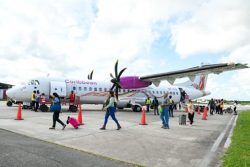Dear Editor,
I refer to a letter written by Mr Elton McRae, which appeared in your newspaper on October 29, 2008, captioned. ‘There were clay roads in Guyana.’ Mr McRae is upset at some of the statements made in a news item carried by Stabroek News on an experimental clay road recently constructed by the IAST in collaboration with the Ministry of Public Works and the Ministry of Agriculture.
It is surprising that a simple news item can elicit umbrage from this gentleman; if indeed he wishes to question the approach or the validity of some of the statements made in the news article, there are collaborative, conducive approaches which are much preferred to the adversarial approach he has elected to adopt. Nevertheless, we are always delighted when there is feedback to our projects, and we thank Mr McRae for highlighting his angst. Perhaps we can appease some of his umbrage by the following explanations.
It was mentioned with no ambiguity at our press event that the practice of building clay roads in Guyana has existed for some time, and still exists significantly in Regions 5 and 6. Indeed, many of the farm to market roads constructed by Guysuco were of burnt clay, and other examples of clay roads in urban and rural areas also exist, as detailed by Mr McRae. We have consulted extensively with individuals who have been engaged in the practice of burning clay for road-building purposes, and have also performed an extensive and exhaustive literature review of the practices utilized around the world to produce kilned clay materials for road building. Our findings indicated that the methods used in Guyana are currently not as efficient as they could be, and generally produce materials which have wide variations in quality. Nevertheless, there are perfectly usable roads of acceptable quality produced from this material, and the practice affords a living to individuals in Regions 5 and 6.
Our efforts were applied to this almost age-old practice so as to introduce some level of scientific scrutiny, higher levels of efficiency, reproducible quality, and a minimization of the amount of fuel required. This is required if the practice is to be adopted as a widespread solution to the current challenges facing the country with regards to the construction and maintenance of roads. As Mr McRae should be aware, if we are to assess the process used with respect to the parameters mentioned above, we have to assess roadways built with materials processed identically, and furthermore, use similar construction designs. It would therefore be a little obtuse to observe roads built in the ’70s and assume that they would conform to the same performance characteristics as those built using the streamlined processes we have utilized.
Indeed, the roads built in the ’70s may perform much better, given the years of compaction that they have been subjected to, as well as, ostensibly, maintenance efforts. It should also be mentioned that in this project, we have also not utilized the very best methods of kilning available, such as the use of rotary kilns, as the process is being geared towards the robust application of a low capital infrastructure to the production of acceptable roads. The economic analyses of cost versus function and lifetime are of paramount importance.
We have not claimed that sun-drying is a new concept introduced by the IAST; that would be ludicrous, for obvious reasons alluded to by Mr McRae. It is only mentioned as part of the process utilized. As far as we are aware, the extrusion process we utilize has never been utilized in Guyana before, and we have not found direct references to it in the literature, although there are many similar efforts. The basic idea is to control the size of the material so that it is uniformly fired, and to provide some compaction of the clay so as to remove air pockets which define fracture planes in the semi-crystalline kilned material. Current practices produce larger particles, with the centres being imperfectly fired, which results in variations in quality. Even now, we are modifying the process to ensure a greater diversity of shapes of the aggregates, whilst maintaining similar aspect ratios. Mr McRae obviously takes offence at the statement that the IAST has developed this extrusion method. If he can provide concrete evidence of this method having been used before, we would be delighted. As far as patenting the process is concerned, Mr McRae, we are involved in a project to build cheap, acceptable roads on the coast of Guyana. This project aims to utilize appropriate, sustainable methods. Having a healthy patent portfolio myself, I can tell you that process patents are difficult to defend and costly to maintain. It takes approximately US$70, 000 to file, execute, and maintain an international patent in a number of jurisdictions, and then there are maintenance charges over the lifetime of the patent. I am not sure how the IAST would be able to generate income from owning such a patent, even if one could be defended. If Mr McRae has suggestions of a workable business model to extract revenue from such patents in Guyana, we would be obliged to receive his help.
In closing, I again thank Mr McRae for ventilating his concerns on this project. Should he be further inclined to offer criticisms, suggestions and advice, may I provide our telephone number – 592 222 4214, or an email address to which he can send his comments – csec_iast@yahoo.com.
Yours faithfully,
Professor Suresh S. Narine





